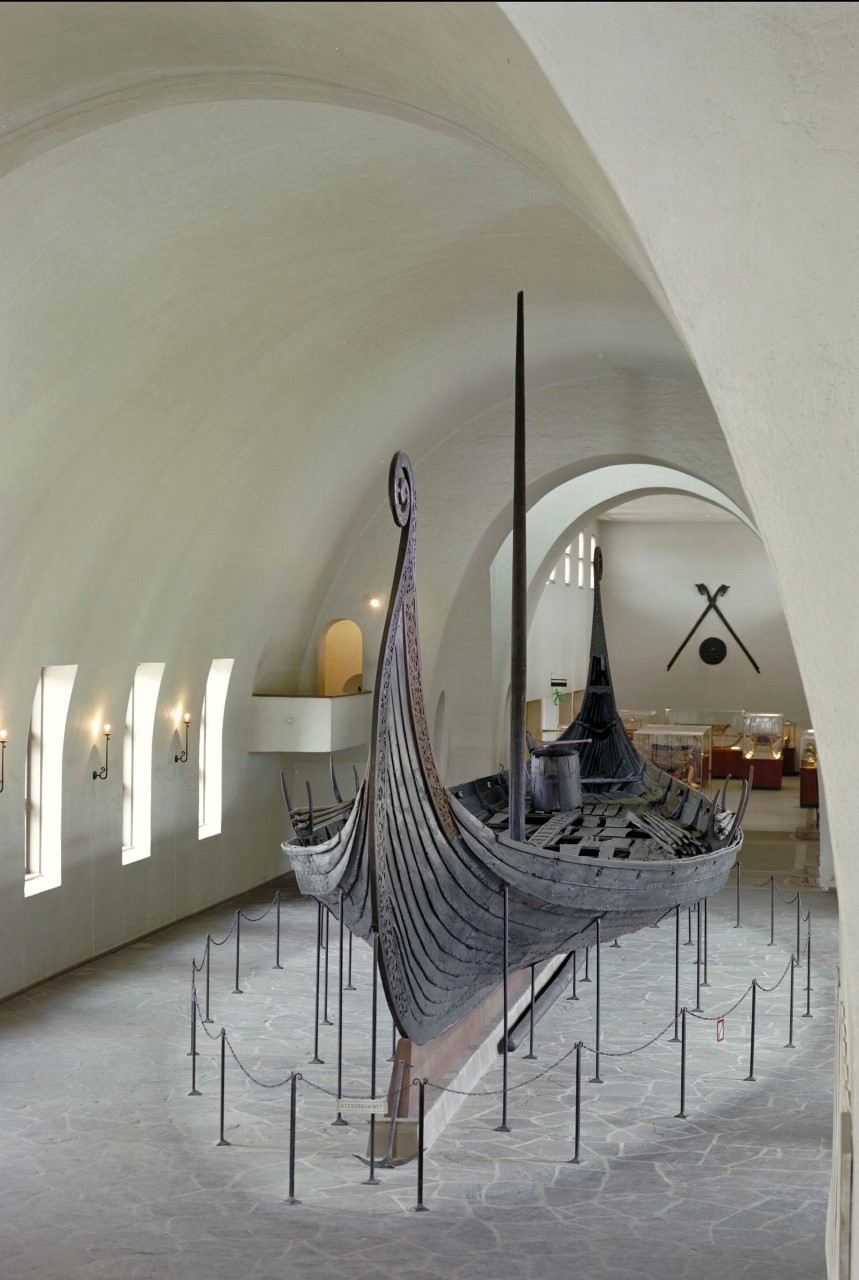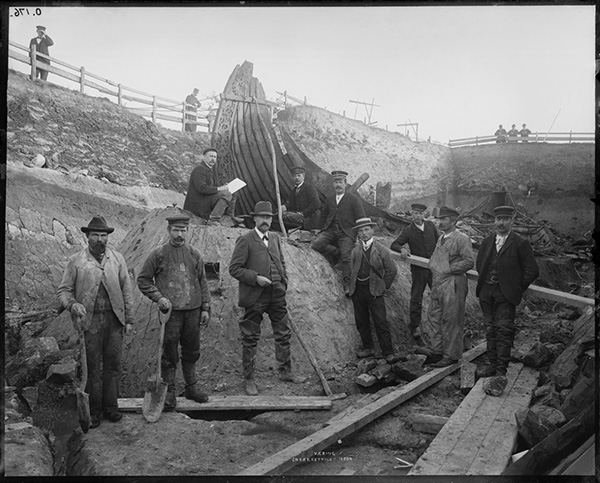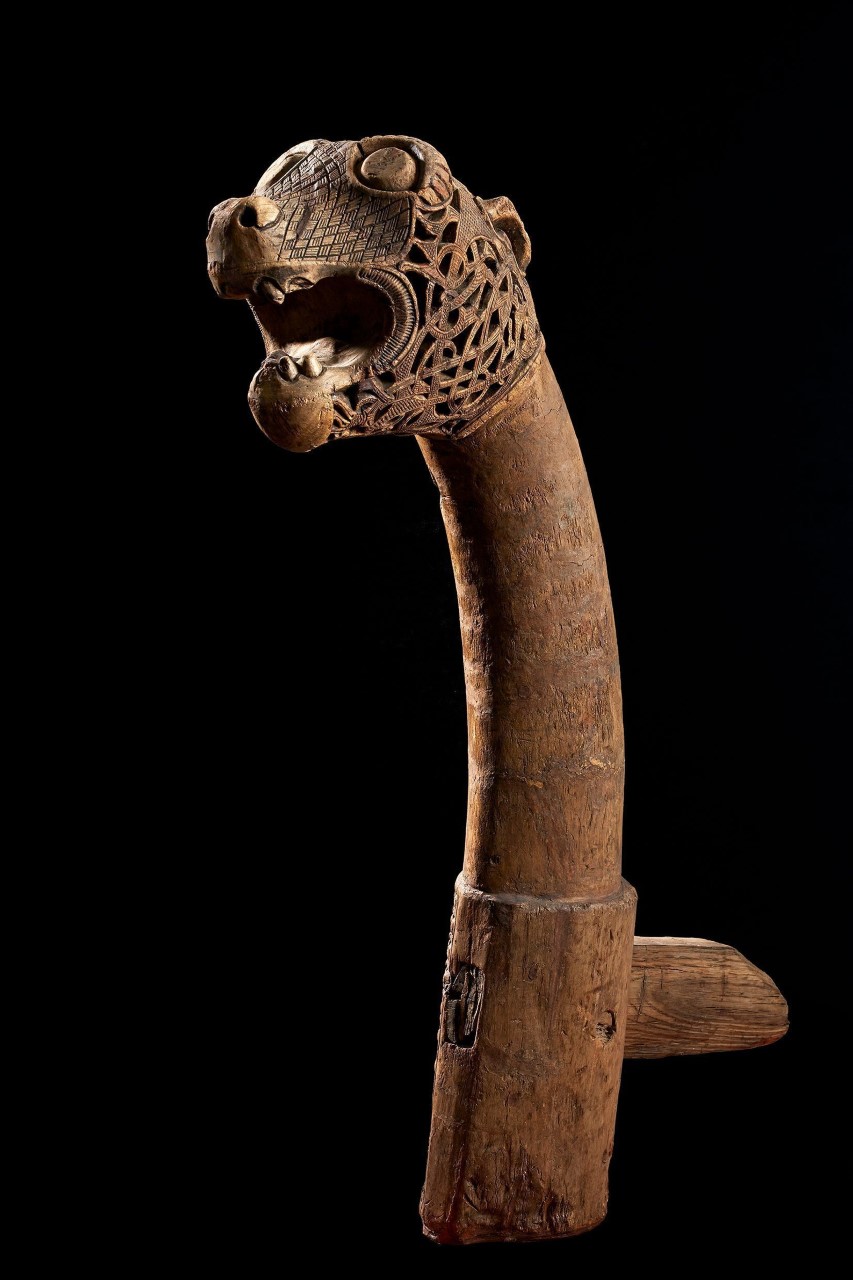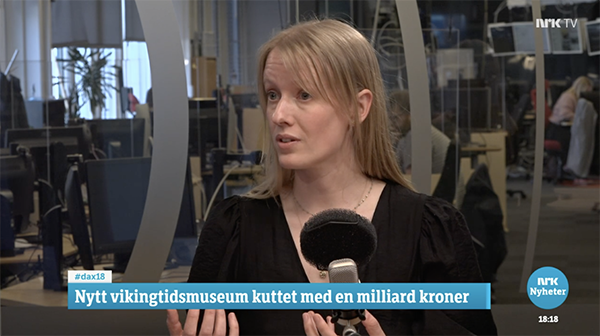Marie D. Amundsen & Unn Pedersen (HEI: Heritage Experience Initiative, University of Oslo)
Earlier this year, the unique Viking ship collection at the University of Oslo was suddenly placed at risk, as the result of political haggling over price tags. See Figure 3. The ‘Save the Viking ships’ petition (publicised by the EAA to its Members via email on June 14, 2022) was initiated to make politicians aware of their responsibility towards this unique and highly-vulnerable heritage that is valued by people worldwide.

Figure 3: The Oseberg ship as exhibited in the Viking Ship Museum. © Museum of Cultural History, University of Oslo, Norway. Photo by Eirik Irgens Johnsen.
The Viking Ship Museum at the University of Oslo, Norway, has exhibited the best-preserved Viking ships in the world for almost a century. In addition, it houses a unique collection of artefacts found in the ship burials at Oseberg, Gokstad and Tune. Safeguarding the collection has been a concern for museum professionals since the ships were unearthed in the 19th and early 20th centuries. See Figure 4. Ten years ago, a panel of experts appointed by the Norwegian government concluded that the construction of a new museum near to the existing one was crucial in order to preserve the Viking ship collection for the future (Horn and Grimsrud 2022). The collection is currently in a precarious state of preservation. It needs specialist intervention both in terms of conservation and the environment in which it is housed.

Figure 4: Excavation of the Oseberg ship 1904. Professor Gabriel Gustafson and crew. © Museum of Cultural History, University of Oslo. Photo by Olaf Væring.
In 2015, an international architectural competition was announced for the design of the new museum, which resulted in 111 contributions. AART architects won with a proposal for the addition of a round building to the existing museum (by the well-known architect Arnstein Arneberg), which quite literally drew a circle around this important cultural heritage assemblage. On 1 October, 2021, the old museum closed its doors to safeguard the collection prior to the construction of the new Museum of the Viking Age, which was scheduled to open to the public in 2026 (Museum of the Viking Age 2022; Statsbygg 2022). However, in spring 2022, just a few months ahead of the start of construction work, the project was placed on hold by the government. They demanded massive budget cuts. The ships and the collection were placed in grave danger as years of planning and preparation were suddenly cast aside.
The projected costs had risen as result of the pandemic, increased material costs and the complexity of this unique project. The Ministry of Education and Research still wanted to cut costs, and warned that the entire project had to start all over again. Museum professionals responded immediately, telling the Norwegian government that all unnecessary delays at this point exacerbate risks for the collection, now in temporary storage. While the government deliberated over the price tag, the priceless ships and artefacts that the project had been initiated to safeguard (see Figure 5) sat packed away and in very real danger of disintegrating. Moreover, they had already been closed off from the public, and could not simply be unpacked and re-exhibited in their current state (Horn and Grimsrud 2022; Fuglestvedt 2022).

Figure 5: Animal head post from Oseberg. ©Museum of Cultural History, University of Oslo, Norway. Photo by Kirsten J. Helgeland.
The building commissioner for the Norwegian government (Statsbygg) and the University of Oslo put together a report, checked and approved by an independent third party (Holte Consulting 2022; Statsbygg 2022). The report, handed over to the Ministry of Education and Research on 10 June, concluded that the project cannot be completed if the costs are cut. Without the increased funding, the established project goals to provide long-term safety for the ships and collections while also allowing for public access cannot be realised. With a lesser budget, the preservation of this unique collection simply cannot be guaranteed. On the same day that the report was submitted, the principal of the University of Oslo, Svein Stølen, and Museum Director of the Museum of Cultural History, Håkon Glørstad, published an opinion piece urging the Norwegian government and parliament to stick to the original plan and to realise the long-awaited museum without further delay (Stølen and Glørstad 2022).
Fearing that the politicians, with the Minister of Research and Higher Education in the front seat, were not listening to cultural heritage professionals and did not recognise the urgency of the situation – or indeed the value of the ships and artefacts – we decided to take action to demonstrate the global appeal and concern for this unprecedented collection of cultural heritage materials. Ever since the excavations at Oseberg and Gokstad, public interest in the Viking ship burials has been massive. This interest is real, living and present. It is visible not only in the large number of visitors to the Viking Ship Museum each year, but also in the continued interest exhibited by persons both young and old for these fascinating remains from a past long gone. In an attempt to capture the public interest and make it visible, we started an online petition. Viking Age researchers and colleagues from the Nordic countries came together on very short notice for the proposal, and the petition quickly went live (Change.org petition 2022).
The response was immediate and overwhelming. We had hoped for maybe 500 signatures. We would have been very satisfied to reach 1500. But, the petition spread like wildfire. Within the first few hours our goal of 500 signatures was reached. Within 24 hours, we had received more than 3000 – double our most optimistic hopes. It was not long before the media caught on, and signatures continued to pour in. Though most archaeologists and museum professionals in Scandinavia signed, the public proved to be deeply engaged in the petition as well. At the time of writing, the response stands at 20,000 signatures! These come not only from Norway or even Scandinavia, but from around the world. It is clear that even though the Viking ships are not officially on the UNESCO world heritage list (yet), they are indeed considered by many to be world heritage.
On 14 June, the 2022 Norwegian Revised National Budget was settled, and gave us hope. In the amendments to the budget, it was noted that the government wished to review the project, but also that, while said review was being done, necessary work to secure the collection would continue (Prop. 115 S 2022:152). This first joy was unfortunately short-lived. In a debate on The Norwegian Broadcasting Corporation (NRK) that same evening, it became clear that what was to be deemed ‘necessary’ was up for debate. See Figure 6. The museum would still suffer delays and cuts. At this point, media coverage of the new museum and the petition was ubiquitous. The University of Oslo’s message to the government was clear: Only the original project can deliver what is required to safeguard and preserve the ships and collections. It is the only way for this amazing collection to be preserved and exhibited for future generations. Meanwhile, signatures on the petition kept pouring in, together with many comments questioning the government’s decision and pointing out the need to care for the ships and collection. Heart-warming stories also emerged, of experiences from the Viking Ship Museum along with people’s express desires to come and see the ships in the future. Before long, Stølen and Glørstad, together with Ellen Horn, the Chair of the Board at the Museum of Cultural History, published an appeal on behalf of the University of Oslo to the Norwegian government. They requested that the government not delay the build of the new facility any further, pointing to the perilous circumstances of the ships and collections once again (Stølen et al. 2022).

Figure 6: Screenshot from debate on Dagsnytt 18, NRK, 14 June 2022. Marie D. Amundsen talking about the ´Save the Viking ships´ petition, the importance of this cultural heritage and the new museum.
On 22 June, the news broke. The project budget now stands to be increased by 700 million NOK, which will safeguard the ships and collections in the building. This is an important step towards realising the museum according to plan. Everyone that has signed the petition has been a part of this. We extend our sincerest gratitude to everyone that has and continues to offer their support. Although the government is increasing funding for the new museum, it will be only partial. Unfortunately, to realise the project as planned, 300 million NOK is still insufficient. Thus, cuts will have to be made. These cuts will mostly affect visitor’s experiences, particularly limiting programs directed at children. Unfortunately, as a direct result, the societal gains will be diminished.
We are of course very pleased that the ships and the collections will be secured in the new building, and that there will be no more delays. These are the first priorities. However, we do not agree that political processes should put a stop to visitors’ valuable engagement with cultural heritage. Therefore, our message to the Norwegian government and the Parliament (Stortinget) is still the same: Only the original project can deliver what is needed—safeguarding and preserving this exceptional heritage for the future and the many people who will visit, learn from, and deeply appreciate the premier experience that will be the Museum of the Viking Age. Therefore, the petition will remain open until full funding for the original project is secured.
As heritage professionals, it has been extremely encouraging to see the comments left by those signing the petition. While we have elected to share a few of these below, all are available on the online petition.
- It's so important to preserve this history so future generations can learn about it.
- I'm signing because some things are more important than politics. Once these items are damaged or destroyed they are gone forever.
- Culture needs to be looked after and preserved, once gone is gone. When it goes we lose a little understanding of ourselves.
- I'm signing because the viking ships are amongst the most beautiful historical artefacts I have ever seen. I visited in 1990 and it has been a lasting memory. It is madness to discard this jewel in Norway's and the world's, archaeological history.
- My 8 year old just learned about the 3 best-preserved Viking ships yesterday. Please continue to preserve these so he can see them one day …
- I sign because the Viking ships on Bygdøy are such an important part of our cultural heritage and of the world heritage and it is completely unacceptable that politicians put their future in danger. There is no time to lose in the work to secure them for the future.
- If funding needs to be cut, cut from things that detract from culture and life, not things that add to the richness and value of life.
Bibliography
- Change.org petition 2022. Redd vikingskipene! / Save the Viking ships! https://www.change.org/p/redd-vikingskipene-save-the-viking-ships, accessed June 30, 2022.
- Fuglestvedt, Ingrid 2022. Kort sagt, tirsdag 31. mai: Vikingskipene forsvinner. Aftenposten. https://www.aftenposten.no/meninger/debatt/i/V9n65l/kort-sagt-tirsdag-31-mai?fbclid=IwAR3JxPREB4nc_eSoBc8DDdCr-n3YAnnZCb8ej6rylhkP2usKFk9O8uuCPHM, accessed 30 June, 2022.
- Holte Consulting 2022. Notat om Statsbygg sitt arbeid vedrørende nedskalering av Vikingtidsmuseet, utarbeidet for Kunnskapsdepartementet 2. juni 2022, https://www.uio.no/om/aktuelt/aktuelle-saker/2022/notat-holte-consulting-vikingtidsmuseet.pdf, accessed June 30, 2022.
- Horn, Ellen, and Bjørne Grimsrud 2022. Opinion piece: The Viking Ships can’t wait. Sciencenorway.no, May 25, 2022. https://sciencenorway.no/archaeology-opinion-researchers-zone/the-viking-ships-cant-wait/2030713?fbclid=IwAR06CyflYpWvJVMAl8JaikAxHyxWrRrttB12482ykcABRtEdWCcovHYNZLE, accsessed June 30, 2022.
- Museum of the Viking Age 2022. The new Museum. https://www.vikingtidsmuseet.no/english/the-new-museum/, accessed June 30, 2022.
- Prop. 115 S 2022. Proposisjon til Stortinget (forslag til stortingsvedtak). Tilleggsbevilgninger og omprioriteringer i statsbudsjettet 2022, edited by Det kongelige finansdepartement, https://www.regjeringen.no/contentassets/7e782a01911c4a5ab58f5512eef9f9ad/no/pdfs/prp202120220115000dddpdfs.pdf, accessed June 30, 2022.
- Statsbygg, and Universitetet i Oslo 2022. 1011301 VTM, Nybygg for Vikingtidsmuseet ved Universitetet i Oslo, Rapport – føringer for videre arbeid - svar på bestilling fra KD 6. mai 2022, https://dok.statsbygg.no/wp-content/uploads/2022/06/RapportVeienVidere.pdf, accessed June 30, 2022.
- Stølen, Svein, and Håkon Glørstad 2022. Debattinnlegg: Lite å vinne, alt å tape med kutt i Vikingtidsmuseet. Khrono. https://khrono.no/lite-a-vinne-alt-a-tape-med-kutt-i-vikingtidsmuseet/695771, accessed June 30, 2022.
- Stølen, Svein, Ellen Horn, and Håkon Glørstad 2022. UiOs appell til Regjeringen: ikke utsett byggeprosjektet, accessed https://www.khm.uio.no/om/aktuelt/aktuelle-saker/uios-appell-til-regjeringen-ikke-utsett-byggeprosj.html, June 30, 2022.
Go back to top